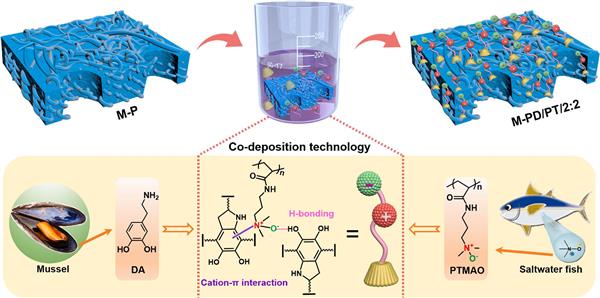[Separation and Purification Technology, 2023] Superwetting membrane by co-deposition technique using a novel N-oxide zwitterionic polymer assisted by bioinspired dopamine for efficient oil–water separation
writer:Jing Yang, Ligang Lin*, Fengling Tang, Junqiang Zhao**
keywords:Oil-water emulsion separation, Superwetting membrane, N-oxide zwitterionic polymer, Dopamine Biomimetic co-deposition technique
source:期刊
specific source:Separation and Purification Technology
Issue time:2023年

Superwetting membranes have good prospective for treatment of oil-containing wastewaters. However, development of simple and environment-friendly membranes with efficient oil–water separation performance remains a great challenge that needs to be addressed urgently. In this study, inspired by the secretion of trimethylamine-N-oxide (TMAO) by saltwater fish, we report a novel N?oxide zwitterionic polymer (PTMAO) with ultralow fouling property possessing directly linked opposite charges in their molecules and superior hydrophilicity, as compared to conventional zwitterionic ones. Using biomimetic co-deposition technique of dopamine (DA) and PTMAO, a zwitterionic polymer network was formed via self-polymerization of DA and followed by hydrogen bonding and cation-π effects between the oxidatively generated polydopamine (PD) and PTMAO. As expected, the fabricated membrane exhibited excellent superhydrophilicity and underwater superoleophobicity. The M–PD/PT/2:2 membrane achieved high efficiency of oil–water separation performance under ultra-low-pressure conditions, with an oil–water emulsion flux of 1121.1 L/m2 h, a recovery rate of 93.1%, and oil rejection as high as 99.2% in the cyclic oil–water emulsion separation process. Meanwhile, the M–PD/PT/2:2 membrane showed excellent stability. Therefore, this work provides a new idea for the preparation of superwetting membranes using dual-biomimetic techniques for effective separation of oil–water emulsion.